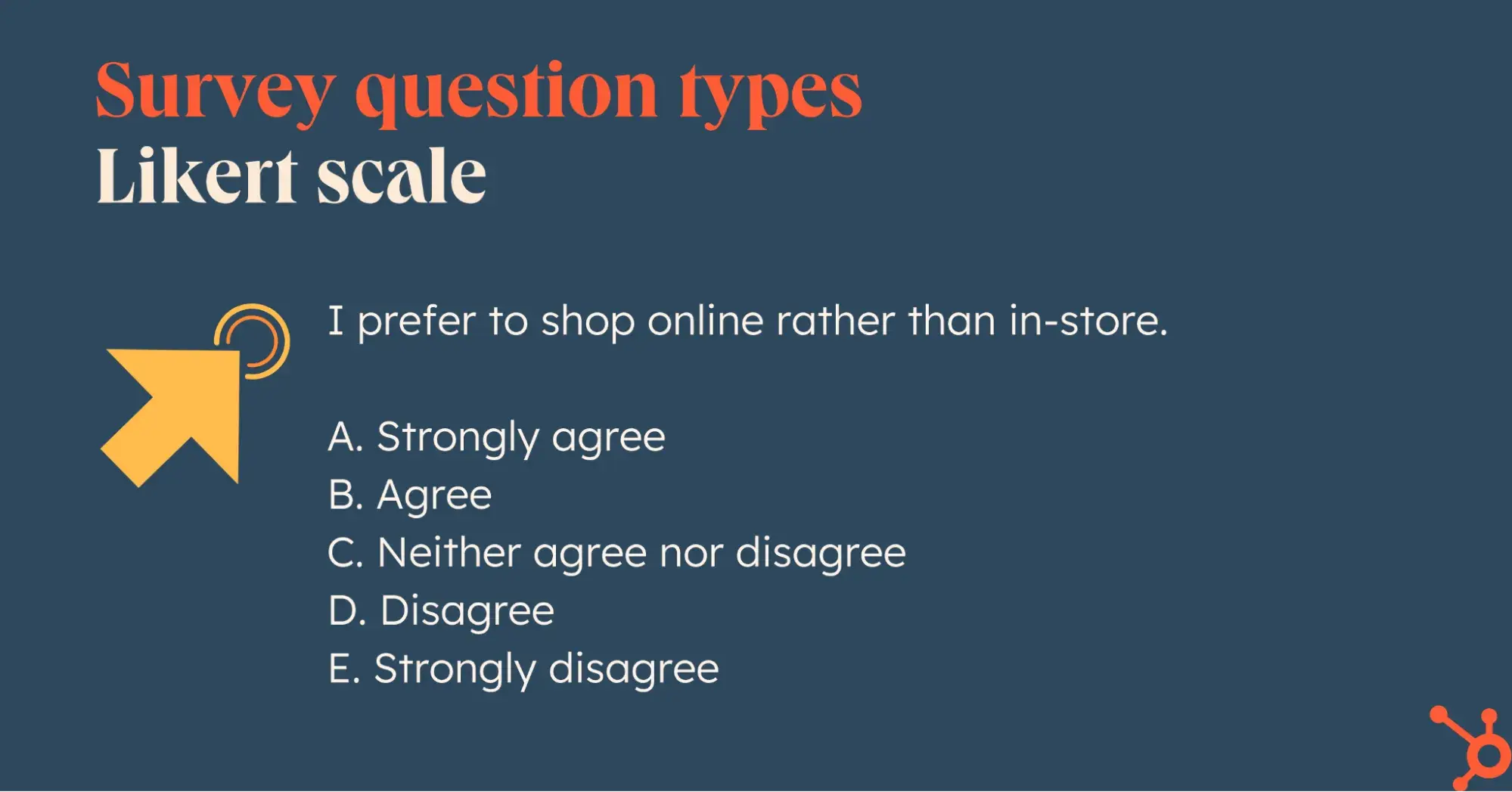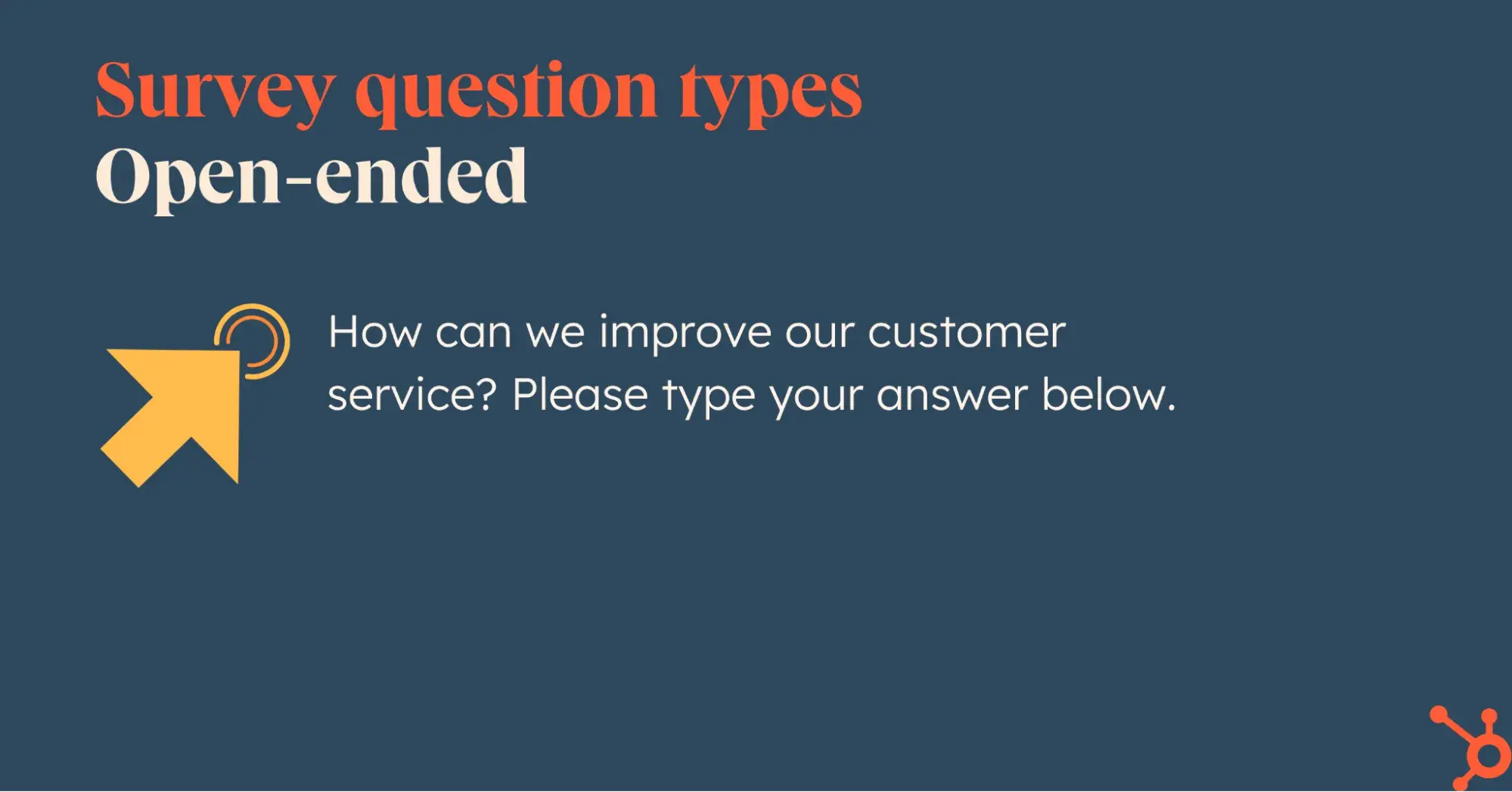Table of Contents
- What Is Survey Design?
- The Three C's of Survey Design
- How to Design a Survey
- 13 Survey Design Best Practices
- Survey Design Examples
What Is Survey Design?
Survey design is the creation, formatting, and stylization of a survey. This trio plays a crucial role in motivating participants to complete survey questions. When surveys are specifically designed for a target audience, participants are more likely to finish them and provide your business with valuable feedback.
As highlighted in the image below, if you create a survey template, format your questions, or style a survey’s look, you’re participating in survey design. There are three things to keep in mind during the survey design process. I'll discuss them next.

The Three C's of Survey Design
Whenever you’re creating a survey, it’s important to consider the three C's outlined in the image below: clear, concise, and communicative. These core factors influence your survey design and help distinguish between good and great surveys.

1. Clear
If your survey design is clear, that means participants aren't left with questions about the purpose of the survey and how to complete it.
To determine if your survey is clear enough, ask yourself:
- Are my survey questions easy to understand?
- Does each survey question elicit a specific answer?
- Will my participants understand the point of each survey question?
Pro tip: If the questions seem hard to understand, random, or out of place, participants are more likely to lose focus — and less likely to complete your form.
2. Concise
Brevity is vital in survey design because respondents shy away from lengthy or time-consuming surveys.
These four questions can help you decide whether your survey is concise:
- How long is my survey?
- Is it the ideal survey length?
- Is it less than 30 questions?
- Are my questions worded succinctly and only asked once (not rephrased or asked in multiple ways)?
Pro tip: Pay close attention to these details, as the length of your survey is one of the most important factors that influence its completion rate.
3. Communicative
You also want your survey to communicate your intended message. That way, your results will be meaningful to your objectives.
Here are a few questions to help you ensure your survey design is communicative:
- Will the questions help me achieve my major goal?
- Does each question hold weight in producing meaningful insights?
- Are there questions that are irrelevant or that may distract participants?
Pro tip: Your survey should only include your need-to-have questions, so it's especially important to make the right selection.
The Three C's of survey design will help improve the quality of your survey tremendously. But you can also check out the video below from SAGE Publishing to learn more about how you can effectively design the right survey for your audience.
How to Design a Survey
There are so many types of surveys out there, and depending on what kind of topic you’re covering it gets even more complicated. But fear not — I’ve developed some survey creation strategies that’ll help you design for the audience you want.

1. Set a goal for your survey.
Before designing your survey, you should come up with a goal or set of goals you want to achieve. Without this benchmark, it’s easy to get off-topic and lose sight of your survey’s purpose.
Pro tip: Your goal should be simple but specific. Rather than, “I want to evaluate employee satisfaction,” consider a more precise goal like, “I want to understand what's causing rapid turnover on our customer-facing teams.”
This will provide you with a roadmap to your survey design, making it easier to determine your questions and how best to order them.
2. Set expectations for your respondents.
Respondents want to know how long they’ll spend on your survey — five minutes? 10 minutes? 20 minutes? Let them know. This reduces your survey dropout rate from the get-go.
Pro tip: You can also set expectations by stating the number of questions, why the survey is worth the respondent’s time, and how you would use the data.
3. Ask relevant questions only.
Asking too many questions isn’t the best use of a survey taker’s time. What’s worse is when the questions aren’t relevant to the survey.
Pro tip: Before sending your survey, read it and delete questions that don’t align with the premise of your research. This keeps your survey short, easy for respondents to complete, and cuts down on the time you need to analyze responses.
4. Strike the right balance between question types.
There are two main types of questions you can choose to include in your survey: close-ended and open-ended.
Close-ended questions are questions that include pre-determined answers created by the survey designers. Typically, these questions come in multiple-choice or checkbox format, and participants choose from the options provided.
Including more close-ended questions in your survey helps you produce quantitative results. These results are easier for consumers to respond to and for you to analyze.
Open-ended questions help you gather qualitative data. But since they take longer to fill out and review, it's best you include them when you want specific feedback or when you’re working with a small audience.
Cameron Lee, CEO at ACCURL, mentions that it’s essential to have a balanced mix of questions as such: “70% close-ended questions for easy analysis, 20% scale/rating questions to gauge sentiment, and 10% open-ended questions for deeper insights. With this, you can make sure that you get enough useful feedback without overwhelming respondents."
Pro tip: Be sure to place any open-ended questions towards the end of the survey as they take more effort to complete and can sometimes overwhelm the participant. The best place to put them is about three-quarters into the survey before participants experience survey fatigue.
5. Don’t make all of your questions required.
There are two drawbacks to making all of your survey questions required. The first is massive dropoffs, as respondents who can’t answer a required question correctly will abandon the survey. The outcome of this setback is you need a much wider pool of participants to get a statistically significant sample size.
The second challenge is that you could get inaccurate and misleading data from respondents who select random answers for questions they can’t answer accurately. So before hitting send on your survey, rethink your decision to make any question required.
6. Ask questions your respondents can answer accurately.
If a question doesn’t elicit a quantitative answer, chances are the response may be inaccurate. For instance, “Did our blog post directly influence your decision to sign up for our newsletter?”
This question can get inaccurate responses because other things could have influenced the survey takers. This can be a brilliant LinkedIn post by your employees, a tweet from your brand that they like, or the mention of your brand by someone in a niche community.
In other words, the blog post was the conduit the respondent needed to sign up for the newsletter. Even if you include ‘other’ in your options, some respondents may forget what influenced their decision. The result? Misleading or inaccurate data.
7. Incorporate response scales.
Response scales show the intensity of someone's attitude towards a specific topic. With tools like HubSpot, these types of responses provide in-depth customer feedback on how your audience feels without using open-ended questions.
Rather than offering ‘Yes/No’ or ‘True/False’ responses, you can use a 5-point Likert scale. This way, participants are presented with a series of statements and asked to rate their opinions using a scale with opposite extremities.
For instance, rather than asking, “Do you come to our stores often?” you could phrase the question like this:
How often do you come to one of our stores?
A. Very Frequently
B. Frequently
C. Occasionally
D. Rarely
E. Never
This format gives you more specific feedback on your topic while maintaining a quantitative, closed-ended response.
8. Provide an opt-out option for multiple-choice questions.
If a respondent can’t find their preferred answer among your options, you need to allow them to skip the question or provide an open-ended response. This keeps the survey taker at ease, avoids forced responses, and ensures you get accurate data.
For every multiple-choice question, ensure you include one opt-out option like: None of the above, Other (Please Specify), Other (Please explain), Not applicable, I don't know, and Prefer not to answer.
9. Order your questions logically.
If you don’t arrange your questions in the most logical and simple order possible, your survey respondents will drop off.
Generally speaking, you want to establish the survey topic and begin with broader survey questions. As the respondent progresses through the survey, you should then start asking more focused questions.
Regardless of the circumstances, the most important thing is to make sure your survey makes sense. Make sure that the questions are arranged logically and that you haven't jumped around too much after deciding which to include and in what sequence.
10. Check the length of the survey.
For the most part, if someone is completing your survey, that means they’re doing you a favor. There's no better way to show them how much you appreciate their time than by not hogging it.
Remember, nobody wants to waste thirty minutes answering your questions. While there is no set length for an online survey, Pew Research Center has set a 15-minute maximum for its American Trends Panel (ATP) trends, which has seen an 80% completion rate.
So, without compromising the quantity of information you can collect, keep your survey as brief and straightforward as you can. Ultimately, you will be rewarded with more meaningful answers to the questions you ultimately choose to include, along with a better completion rate.
11. Personalize the survey throughout.
One of the most important survey creation strategies is that you’re making survey participants aware of the brand. As a matter of fact, customers will be more likely to trust your brand if it is prominently displayed in all of your interactions.
This increases more when you add your logo, color scheme, and brand-associated images increase the effect. A branded survey will make respondents — whether they be customers or staff — feel more connected.
You can also personalize the survey by using the respondent's essential demographic information, which you get at the beginning of the survey, to set questions. Try to include something relevant to them. Maybe you can display their name at the top, or you can cater to the audience’s region by adding more language options.
12. Test your survey.
Once you’ve designed your survey, test it before sending it to stakeholders. You want to make sure the survey is effective and that it’ll collect the data you're looking for.
Conducting a test run on a small sample size or internal employees can help your team catch overlooked errors. Getting fresh eyes on the survey will ensure there are no missing questions, misspelled words, or biased wording that you may have missed.
It’s best to find these problems now rather than discovering them after the survey’s been distributed.
Also, use this opportunity to gather feedback on the survey's design. Is it too long? Is it boring? Are any questions confusing or repetitive? Do the questions make sense?
Use this feedback to edit your survey, then test it again by following survey writing best practices. Repeat this process until you get a positive response from your participants and are prepared to send out the final draft.
13. Analyze your results.
Whether the survey's goals have been met or not often tells you how well your survey was designed. In the event that you don’t get your desired insights, it is the ideal time to revisit your survey design and refine it for your target audience and objectives.
If you want to ensure you receive the data you need, I advise testing your surveys several times. Conduct specific focus groups, ask experts to review them, and speak to your respondents over time. Once you’ve identified where you’ve gone wrong, you can set up improved questions or even a new structure to see whether the insights you’re getting are accurate.
Now that you’re familiar with survey creation strategies let’s take a look at what else you can do to ensure your survey does well.
13 Survey Design Best Practices
Anthony R. Artino, Jr., a researcher at George Washington School of Medicine and Health Sciences, mentions that it’s unlikely that we can gather useful information to guide our decision if the survey is of poor quality and the respondents aren’t able to comprehend the questions being asked. In such cases, our survey efforts will have been in vain.
So, it’s essential to follow some survey best practices to make sure we don’t make surveys that go to waste. Let's discuss each one in detail.
1. Don’t ask respondents to self-report data you have.
Asking respondents to provide data that they believe you have can make them lose interest and quit the survey. This data includes contact information, purchase history, product usage frequency, demographic data, subscription status, and many more.
Why’s that? Well, consider you’re asking this question: What is the likelihood that you will ever use this product? Even if a respondent‘s perception of a product’s likelihood of usage may be influenced by its description or a quick tutorial, their response is not a trustworthy forecast. It shouldn't be taken into account when making important purchasing decisions.
Stripping these questions from your survey helps you have one less question, and this can lead to a higher survey response rate. If you must ask questions related to the data you have, ensure they are highly relevant to your research.
- Avoid making predictions. Moreover, if you call for estimates, it can be seen as future predictions. In an ordinary week, how often do you currently use this product? This kind of inquiry is nonetheless unreliable, even though it does not have the prediction issue. Most people find it difficult to make estimates based on a hypothetical “average” week; instead, they frequently remember weeks that were anomalies because they are more memorable.
- Focus on specific events. If the research topic is attitudes and opinions across time, you should deliberately record their most recent opinions first, then ask them to consider how those have evolved over time.
Moreover, if you’re looking to examine people’s attitudes or feelings at different times, ask participants to answer at those times instead of depending on a final poll that is probably biased toward more recent usage.
2. Avoid biased and leading questions.
It's easy to accidentally include biased or leading questions in your survey.
For instance, asking, “How wonderful was your experience with our customer service team?” is a common example of a leading question — a question that encourages the researcher's desired response.
Questions like these undermine the validity of your results, as you can’t trust your data’s accuracy because participants have been subjectively influenced by your team. Such questions could also turn off some respondents who may drop out of the survey.
Instead, you can ask this question by saying, “How would you rate your experience with our customer service team?” This maintains an unbiased attitude, encouraging respondents to answer honestly.
- Think before using certain words. When you include a statement like “wonderful service” “fast shipping,” etc, you are expressing a biased opinion. In this case, if you use leading words either positive or negative, it forms a skewed answer in your customers’ minds and makes them doubt themselves.
- Re-check your tone. You’ll see that most adverbs and adjectives have the potential to inadvertently lead to biased questions. They’re already set up so that your respondents answer in a certain way, that’s why you should re-read your sentences to find and avoid any biases included and find how the question can be asked in a neutral tone.
3. Avoid double-barreled questions.
These questions ask participants to respond to two separate sentiments at once and this can affect the validity of their response.
For example, asking, “What do you like best about our website and social media?” may force participants to answer based on their view of either your website or your social media. You won’t know exactly which one they’re referring to in their answer, and this makes their response relatively useless.
Here’s another question: “Rate how often you use our software for data analysis and reporting?” This question assumes respondents use the software for both data analysis and reporting. Some respondents might use it for one or both purposes. Even if others use the software for both purposes, it's impossible to know what their answer refers to.
- Steer clear of double-barreled questions. A question like, “Do you find the company's return policy and customer service satisfactory?” confuses views of customer service and returns policies, which need to be assessed independently. This can lead to them skipping the question or worse, abandoning the survey altogether.
- Separate the questions. In this case, it’s best to split the question into two separate ones: “Are you satisfied with the company's return policy?” and “Are you satisfied with the company's customer support?” If one isn’t relevant, you can also add an option to skip questions once you’ve got two.
4. Pay attention to your vocabulary and phrasing.
The validity of your data can be jeopardized if your questions are vague or have limited options.
Pro tip: Using absolute words like ‘always,’ ‘every,’ or ‘never’ forces participants to either completely agree or disagree with your questions. This can make some respondents hesitant to answer or even complete the survey.
Take this question as an example:
Do you always shop with our company online?
A. Yes
B. No
The above question has limited options because some customers may shop online and in-store occasionally. In other words, the accuracy of responses to this question is reduced. But notice what happens when you delete ‘always’ from the question. The question becomes straightforward and provides accurate data. You could even use a scale that includes options like ‘sometimes’ or ‘rarely’ for respondents who aren’t in the yes or no category.
- Avoid vague questions. It's important to pose questions that are understandable, precise, and accessible to all respondents. You should be letting respondents react on their own terms since it can bring in inaccuracy. Plus, you shouldn’t limit your close-ended questions to yes and no answers if there’s more you want to know.
- Add a response scale. A response scale is the best choice if you have to choose between two answers. This doesn’t mean you include a scale that requires your target audience to indicate whether they agree or disagree with what’s been said. It’s common for biased individuals to agree with claims more often than not, leading to inaccurate and untrustworthy data.
You can improve a lot of yes/no questions by adding words like “How much,” “How often,” or “How likely.” When it’s possible, think about how a response scale would fit in for more comprehensive data.

5. Keep the wording simple.
Remember the first “C” that stood for “Clear?” You want to ensure your questions are user-friendly, comprehensible, and leave no room for miscommunication. If respondents are unable to comprehend your questions or available answers, you run the risk of adding inaccurate data to your dataset.
A good way to do this is by using casual language and avoiding jargon.
For example, instead of this: “What insights did you procure from your conversation with our customer service reps that ultimately impacted your decision to transition from acquisition to advocacy?”
Try this: “How did your customer service experience encourage you to stay loyal to our brand?” The second version is simple, and every participant will understand it. Avoid the giant run-on sentence, too.

- Don’t use complex words. Respondents are better able to understand questions using clear, concise phrasing. When considering how easy it will be for respondents to understand and reply to a question, it’s essential to consider the demographics of your survey group. For example, if they’re not well-versed in technical terms, they’ll likely give you the wrong answer or skip questions.
- Overexplain if needed. Although we should make an effort to keep survey questions brief and straightforward, it is occasionally required to include succinct explanations or definitions when asking about complicated subjects to avoid misunderstandings. To be sure that any jargon has been eliminated, always test your surveys with the intended audience.
6. Don’t focus on negativity.
If you’re focusing on health (physical or mental), disability, or any specific sensitive topic, be sure to use the right words for your question. The way you phrase it determines whether your survey respondents feel offended or not.
Here’s an example: Don’t say, “Are you battling anxiety?” rather use phrasing such as “Do you have anxiety?” This type of objective phrasing provides a neutral tone that doesn’t come off as rude.
- Don’t use negative wording. The way customers feel after reading your survey questions also determines how they feel when answering them. Negative terms such as “suffering” or “battling” can give a negative experience altogether.
- Say it out loud. If you’re planning on talking about sensitive topics, you should read the questions out to a group first. Take their opinion on how the question makes them feel and make adjustments accordingly.
7. Use images and videos to clarify information.
Sometimes, no matter how well-worded your question is, it still might not be clear to respondents. In these cases, it helps to accompany the question with an image or video to clear up any confusion.
If you want to ask participants how they'd feel about a new product, it may not be enough to describe the concept using just words. Rather than writing a long description, you could include an image for participants to evaluate.
Here's an example question with an image:
Consider the following image before answering the question below:

How much would you be willing to pay for this smartphone?
A. $0-199
B. $200-399
C. $400-599
D. $600-799
E. $800-999
This format is much cleaner and easier to comprehend than just a block of text. Plus, it also gives you the opportunity to ask a series of questions based on one distinct image. In fact, a National Library of Medicine journal found that when it came to responding, 12.4% to 20.0% of respondents preferred visuals with their text answers.
- Avoid image biasing. You shouldn’t use images to sway answers by emphasizing one option over another. It’s essential to remember that images can provide important background for a question so don’t use a image with a frowning face when you’re presenting a question about employee satisfaction, for example.
- Choose relevant visuals. You can still add question types with graphic elements, such as smiley and frowning faces, graphic sliders, and relevant photos or videos. Don’t overdo it, though, just make sure you’re putting visuals where needed. You can put a slider with numbers when asking questions about how many times a respondent has used a product in the last week.
8. Focus on brand consistency.
Clients can be more inclined to trust your brand, especially when you add your branding to all your communications — even your surveys. A Salsify study showed that 46% of customers are willing to spend more for a brand they can trust compared to 30% in 2021.
- Don’t forget about your brand. When your logo and brand-associated components are included, they have a greater effect on respondents rather than a plain survey. So whether they are consumers or staff, they will identify more with it and be more likely to provide better answers.
- Finish with a good impression. Don’t just leave your survey blank at the end; you can add a personalized thank you message that appears at the end of the survey. Also, once the survey is finished, you should direct your responders to your website for more conversions.
9. Make surveys accessible on any device.
With mobile market share at 61.7% and 36.3% for PCs and desktops, it’s becoming increasingly important to create surveys that are compatible with any device.
- Don’t forget about accessibility. It’s more common for people to use a variety of devices for surveys, and if you don’t appropriately format your surveys, your audience will likely miss one end of a question or the font will be too small. This means that they won’t be able to answer questions and will end up frustrated.
- Preview and test your surveys. Before you create your survey, test it across a variety of devices to ensure its formatting doesn't negatively impact the findings and it’s perfectly compatible for any screens/devices. Depending on the screen size, you can show answer scales effectively vertically (best at the top, worst at the bottom) or horizontally.
10. Explain questions around sensitive topics.
To learn more about your target audience, you'll sometimes want to include demographic questions related to ethnicity, income, gender, and more. Some participants are sensitive to these topics, so it’s important to explain why you’re requesting this information.
Paul Eidner, chief operating officer at InboxAlly talks about how important it is to approach each question with empathy and understanding that the topic may be difficult for respondents to discuss.
He says you should phrase the questions clearly and directly without hinting at any judgment. Don’t make assumptions. For example, ask, “Have you ever experienced discrimination?” rather than “How often are you discriminated against?”
If people feel uncomfortable, they might skip your question — or worse, abandon the survey altogether. To make it clear why these questions are being asked, provide a short description explaining why they're important to your research.

- Refrain from insensitivity. A recent study by Marco Gregori, Martijn G. de Jong, and Rik Pieters talked about how customers are becoming less inclined to divulge personal information in surveys. Moreover, subjects that were inoffensive a few years ago have now become politically charged or stigmatized. So, when you’re working with sensitive questions, do your research and see how it can affect the demographic you’re addressing.
- Prioritize privacy. Let participants know that their responses will be confidential and used only for research purposes. And, of course, follow through on your word.
Pro tip: Give respondents the choice to “prefer not to say” in their response or to completely skip a polarizing topic within the survey.
11. Include a survey incentive.
An incentive may help you get a higher survey response rate. From the respondents' perspective, an incentive shows you value their time and input, and this could make them more willing to engage with the survey.
Incentives could also help you get high-quality responses since respondents feel you recognize their effort. Another benefit of incentives is that you have less risk of bias in your results because incentives can attract a broader range of participants.
If a survey taker responds to all of your questions, you may offer a gift card, product discount, coupon, cash, charitable donation, and many more as an incentive. Research has shown that the likelihood of respondents finishing a survey increased when offered an incentive compared to when there was nothing given.
Ryan T. Murphy, sales operations manager at Upfront Operations, highlights that the most effective survey incentives offer tangible value, such as discounts on services or access to premium content that resonates with their audience's needs.
While working on a CRM overhaul for a large client, Murphy offered a 15% discount on their upcoming subscription renewal for participation, which led to a 38% increase in survey responses.
- Decide on your survey incentive. There is no ideal quantity or price for a survey incentive, so you can consider the following three factors to help you decide what kind of incentive to offer and how much to value it:
- Your allocated budget for your survey project.
- How you are going to offer the incentive.
- Who the people or intended recipients are of your questionnaire.
12. Add an open-ended feedback option.
A crucial survey writing best practice is adding open-ended questions to collect more thorough responses. Instead of selecting from a list of options, respondents to open-ended inquiries can write their responses in their own words. These questions gather qualitative data, but it can be challenging to analyze them as they don’t fall under a specific category or have a particular answer.
A common open-ended question is something like “Is there anything else you'd like to share?” at the end of your survey. This can provide some potentially useful information while also helping to ease any frustration for respondents who felt your survey didn’t address the points they were hoping to share. After all, a study from Pointerpro showed that around 37% of respondents finish a survey to give their opinion in this way, so don’t skip out on it.
Pro tip: Craft your questions carefully to ensure that the open-ended response offers insightful information.
13. Summarize your findings.
So, you’ve sent out your expertly designed survey. To wrap things up, you’ll want to set aside time to review, summarize, and analyze your results.
This is the stage when many businesses begin to recognize the importance of survey design. A poorly designed survey will return, well, poor results.
Designing a survey that's clear, concise, and communicative — and aligned with the other survey writing best practices above — will make the reporting process much easier.
In this step, take your time to examine your data and find compelling narratives that you may eventually choose to incorporate into your final report.
- Don’t just depend on raw data. No matter how long or short your survey is, it’s likely that you’ll be in the deep end with numbers, ratings, rankings, or even frequencies. However, the answers you receive might not be organized for you to gain any insight, so don’t just skim through the responses.
- Provide a concise summary with visual information. Express your final findings in simple, concise language and statistics. Use various formats, including graphs, tables, or charts, to represent this concise data.
Survey Design Examples
As shown in the image below, there are several examples of how you can design your survey with different types of questions.

Let's review a few of them here.
Multiple Choice
Multiple choice questions allow respondents to choose one (or more) options from many.


Rank Order
Rank order questions give respondents the opportunity to list different items in their preferred order of importance.

Likert Scale
Likert scale questions include statements where the respondent can indicate how much they agree or disagree with each.

Matrix
Matrix questions allow you to collect data based on two or more variables for each question or list item you include.

Open-Ended
Open-ended questions give respondents the opportunity to leave comments and answer prompts freely, without the constraints of predetermined options.

Maximize Results with Good Survey Design
Good survey design is the best way to ensure your survey results are informative and reliable. Make it easy for customers to give you feedback by designing a survey that works best for both of you.
Editor's note: This post was originally published in September 2019 and has been updated for comprehensiveness.
Survey Creation
.png?width=112&height=112&name=Image%20Hackathon%20%E2%80%93%20Horizontal%20(24).png)

.webp)
![16 best free online survey makers and tools [+ recommendations]](https://53.fs1.hubspotusercontent-na1.net/hubfs/53/free-online-survey-maker-1-20251028-2654831.webp)


![How to conduct survey analysis like a data pro [all my tips + secrets]](https://53.fs1.hubspotusercontent-na1.net/hubfs/53/survey-results-1-20241031-6355381.webp)
![Leading questions: What they are & why they matter [+ Examples]](https://53.fs1.hubspotusercontent-na1.net/hubfs/53/leading-questions-hero.webp)
![How long should a survey be? The ideal survey length [New data]](https://53.fs1.hubspotusercontent-na1.net/hubfs/53/how%20long%20should%20a%20survey%20be_featured.png)



